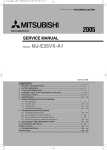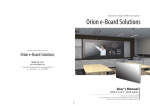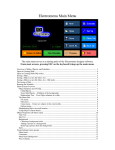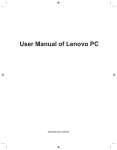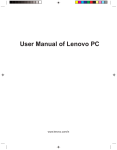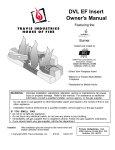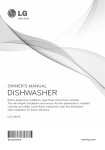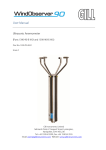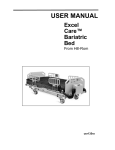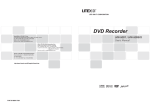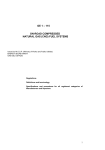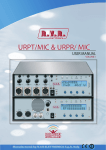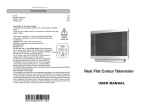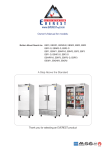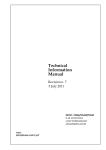Download User Manual
Transcript
PCB0001C-01-BHP-PDII0914 Comfort Window™ Electronic Digital Thermostat Comfort Control System USER MANUAL & QUICK-START GUIDE I. Feature Summary • ComfortWindow Technology • Internet control with compatible WiFi™ network & Webpage/Smart-Phone App • Save on Electricity w/ Hidden Comfort Regions and Economizer Control • Extra Comfort System (“Free Cooling / Heating” w/ Economizer) • Convenient Interface (1-Touch Overrides & Graphical Program Schedule) • Humidifier Control, Auto-Dehumidification • Built-in Ventilation Controls • High Resolution Color Touch-screen LCD (18 bit color, 320x240, 3.5”) • Compatible with most HVAC Systems • Remote Indoor Temp Measurement • Outdoor Temp/Humidity Sensor & Display • Armchair Programming Option Table of Contents: I. Feature Summary ........................1 II. Introduction...................................1 III. Compliance Information................2 IV. Quick-start Guide.........................8 V. Feature Description....................21 VI. Wiring Guide.............................29 Figure 1: Comfort Window II. Introduction Comfort Window is the next generation in smart thermostat design. With innovative energy efficient technology, Comfort Window saves in electricity costs; and with a full color touchscreen LCD, Comfort Window presents a modern and elegant look to fit in with any décor. Comfort Window not only controls temperature, it also controls humidity. With ComfortWindow technology, users can see at a glance whether their home is within their own personalized window of comfort, taking into account humidity. Comfort Window can also cool or heat their home even further into their window of comfort for free by utilizing outdoor air to cool or heat the home when it is possible to do so. Not only does this create a more comfortable environment, it also lowers total compressor runtime significantly, thus reducing electric bills and lowering the home's total carbon footprint. With a comprehensive array of output controls, internet control via smart-phone apps, and outdoor temperature and humidity measurement capability, Comfort Window is truly versatile. www.yourcomfortwindow.com [email protected] Copyright © 2014 1 of 29 PCB0001C-01-BHP-PDII0614 ► Using the provided screws and drywall anchors, III. Quickstart Guide mount the wall-plate to the wall. ► Adjust the angle of the wall-plate utilizing the 1. Record current wiring colors/functions slack given in each of the holes for each screw. ► In order to properly connect wires from a preexisting thermostat to Comfort Window's screw 3. Connect thermostat wire to wall-plate terminals, it is important to know what color wires were connected to what functions on your ► For single compressor, single heater existing thermostat. If the wiring colors are not installations (non-Heat Pump), wire the easily distinguishable, label each wire with its thermostat as shown in Figure 3, according to current function. Chart 1. For any other HVAC configuration, please refer to the Wiring Guide (Section 5). ► While there are some industry-wide coloring ► If a ground wire has not already been pulled to conventions, some thermostat makers do not follow these conventions; it is also possible that the thermostat's location, first see if there are whoever installed any previous wiring may not any unused thermostat wires that you can use have followed these conventions. for Common (C). Otherwise, it will be necessary to run an 18 GUAGE ONLY wire down the wall * *Caution! It is very important to be careful that the existing wires do not fall down into the hole in the wall. and feed it through the hole to the wall-plate. Chart 1: Wiring Configuration for Single Compressor, Single Heater Installations 2. Turn off Electricity & Install Wall-plate Screw Terminal Number 0 1 2 3 ► ALWAYS turn off electricity to the HVAC system at the breaker box before connecting wiring and before connecting thermostat to the baseplate. 4 5 6 7 15 Connect To Jumper to 1 Jumper to 4 Jumper to 3 Jumper to 4 Compressor Transformer +24VAC Compressor Control Fan Control Heat Control -24VAC (Ground) Std. Function Wire Color* PWR RC2 RH2 RH1 N/A Red Red Red RC1 Red Y G W C Yellow Green White Brown/Black** **Note: Brown or Black are the most common colors for 24VAC ground; however, white and blue are also frequently used. * *Caution! While there are some industry-wide color-coding conventions, some thermostat makers do not follow these conventions, so it is imperative to record the previous configuration (both color and function) so the correct wire can be connected to the appropriate location on Comfort Window's wall-plate. Figure 2: Wallplate 3 of 24 PCB0001C-01-BHP-PDII0614 and black wires coming from the RITS sleeve rather than the red, yellow, and black wires that may be in the wall already for thermostat control. Connecting the red, black or yellow thermostat wire to pins 16, 17, or 19 can permanently damage the thermostat and/or remote temperature sensor. * *Caution! Only AFTER connecting thermostat to baseplate should you reconnect electricity to the HVAC system and thermostat. Figure 3: Single Compressor, Single Heater Wiring 5. Install Thermostat onto Wall-plate ► Slide thermostat through the keyed slots on each side of the wall-plate, mating the pins with the receptors until it rests flush with the wall * 4. Install Remote Indoor Sensor ► First, you must install the remote indoor sensor. Drill a 3/16th inch hole ~5 inches below the thermostat. Feed the stripped end of the indoor temperature sensor wire through the hole, angling upwards, and fish the wires out of the hole in the wall-plate*. Or, route the remote indoor sensor to the location in the house you Figure 4: Thermostat to Wall-plate Installation wish to measure temperature. Connect sensor * wires to wallplate according to Chart 2 and Figure 3. *Note: If you are unable to fish the indoor sensor wire out of the hole in the wall under the wall-plate, connect the sensor wires to the wallplate and simply drop the remote sensor into the wall cavity to measure your home's internal temperature. Chart 2: Wiring Configuration for Remote Indoor Temperature Sensor *Caution! Incorrectly mating the thermostat to the baseplate can potentially cause permanent damage to the thermostat or to the remote temperature sensor. Only AFTER thermostat is connected should you reconnect electricity to the HVAC system & thermostat. 6. Re-Apply Power & Configure Thermostat ► Reconnect electricity at the breaker box. If your system is something other than a Single Compressor / Single Gas Heater * system or if you have any extra outputs other than those Screw Std. Terminal Connect To Function Wire Number Color* 16 Remote Temp Sense 1 T1in Black** 17 Remote Temp Sense 2 T2in Yellow** 19 Remote Temp Sense 3 T3in Red** shown in Chart 1, it is critical to first configure the settings for the thermostat, the Regular vs Heat Pump mode setting, and the Gas/Electric Heater setting. Touch the settings icon, scroll **Note: The remote indoor temperature sensor (RITS) wires are contained within an insulating sleeve. Take care to connect the red, yellow, 4 of 24 to the second page, and configure the Equipment Control settings appropriately. PCB0001C-01-BHP-PDII0614 ► Next, set the Date/Time and set your Comfort Window Settings. To reach the settings page, follow the touch diagrams sequence below. ► Set Date/Time: Touch the Settings icon and select the Set Date/Time selection, and set the date and time appropriately. Note that Comfort Window automatically adjusts for Daylight savings time.ext, set the Date/Time and set your Comfort Figure 5: Equipment Controls Page Figure 6: Set Date/Time Page 5 of 24 PCB0001C-01-BHP-PDII0614 ► Set Your ComfortWindow Settings: Set your personalized comfort window settings by pressing the Settings icon on the Home Screen and then pressing the Set Comfort Window Settings button. Adjust each setting to your comfort preferences.* *Note: The Comfort Settings will be the default settings for the thermostat when there are no program entries scheduled to run. Also, it is recommended to maintain the Relative Humidity settings between 20% and 55% RH to reduce potential for mold or mildew growth. Figure 7: Program Comfort Window Settings 7. Configure Thermostat Program Figure 8: Configuring Program Schedule ► Touch the calendar icon in the icon menu bar at the bottom of the home screen. You may need first select the entry in the calendar, and then to scroll over to see all of the available icons by edit by touching the Edit button. In the screen using the arrows to the sides of the icons. that appears, specify the start and end times, the high and low temperature settings, and ► A sample program schedule for a typical work week will be loaded by default. If you wish to which days for which the setting applies. start from a different starting point, load a *Note: With the Comfort Window, there is no need to ensure that all of the program settings align end to end as is necessary with other programmable thermostats. Whenever a program setting expires, Comfort Window will automatically revert the temperature and humidity settings back to your personalized ComfortWindow settings. If you desire to have the program control the settings at all times without reverting back to the ComfortWindow different sample program schedule using the internet controls online or on your smartphone. ► Add as many or as few entries into the program as you desire* by touching the Add button on the calendar home screen. To edit any entry, 6 of 24 PCB0001C-01-BHP-PDII0614 settings, simply create as many or as few settings for each day as you would like and align the settings so that they do align end to end. Also note that it is typical to only have 3-4 entries total since each entry can be associated with multiple days. This makes it very easy to set up a program schedule from scratch. 7. Override ► If you desire to temporarily override the thermostat's temperature setting, simply touch the up or down arrow on the home screen. In the screen that appears, set the temperature to the desired level. Specify the duration of the override by adding or decrementing the override time. Figure 9: Performing Manual Override 7 of 24 PCB0001C-01-BHP-PDII0614 IV. Feature Description Comfort Window provides true comfort control, saves electricity costs, and gives you a convenient and elegant user interface. Figure 10: Home Screen Comfort Control Comfort Window builds on the traditional model of a programmable thermostat, adding a crucial layer for comfort control. With ComfortWindow technology, the Comfort Window not only eases the programming difficulties of most programmable thermostats, it also provides baseline comfort settings used when there are no program entries set to run. Additionally, with humidity/ temperature compensation, you won't feel clammy or sweaty when your thermostat is supposedly within the appropriate temperature range, but instead Comfort Window will compensate the temperature to accommodate what humidity levels are in your home. As such, users will feel less variation in comfort when they set their thermostat to any given value. To help you visualize how the temperature and humidity levels in your home correspond to your personalized comfort settings, Comfort Window also Figure 11: ComfortWindow provides a quick way to view your home's current conditions. The ComfortWindow technology on the home screen will show the current conditions in graphical format, with temperature on the vertical axis and humidity on the horizontal axis. As long as the dot is within the window on your home screen, you can know that your home is within your personal window of comfort. ComfortWindow technology not only provides a quick and easy way to view if your home is within your window of comfort, it also provides a way to make sure your thermostat is doing its job to save you money for times when the current condition point should be outside of your ComfortWindow settings (ie: during a program entry). To change your ComfortWindow settings, simply touch the ComfortWindow quickview graph or go into the settings and touch Comfort Window Settings. Comfort Window does the hard work for you by calculating things like heat enthalpy which take into account the humidity within the air rather than relying solely on a raw temperature reading. This will enable you to concentrate on more important things in life, rather than being bothered by changing your thermostat every time the humidity levels change within your home. 8 of 24 Figure 12: ComfortWindow Settings PCB0001C-01-BHP-PDII0614 Electricity Savings According to Energy Star, “as much as half of the energy used in your home goes to heating and cooling.” With this much energy being spent on heating and cooling, it is essential to install a thermostat that will think wisely about when to turn on the furnace and AC. Comfort Window uses an innovative method, with our Economizer feature, to bring outdoor air indoors to heat or cool a home whenever it is possible and advantageous to do so. This is especially useful in the evenings in the Spring and Fall months where the air outdoors has dropped in temperature quickly while the air inside your home is still hot and stuffy. The reason that the outdoor air temperature may quickly fall while the air inside is still hot is that your walls and furniture hold the heat from the middle of the day much longer than the quickly moving air outdoors, and this thermal mass continues to radiate off this heat into your living space well into the evening. These evening hours are significant in terms of time that we spend awake and active inside of our homes, and so it is important that we can condition our homes during this time of day. much humidity you could be allowing into your home – opening yourself up to potential indoor air quality issues, letting uncomfortable air inside, and even problems due to mold or mildew growth. Comfort Window constantly measures the outdoor humidity, taking out the guesswork as to when to actually open the windows, and computes the enthalpy to be sure that only the air that should be let in is let in. Also, manually opening windows will only solve the problem when you are able and willing to go and open your windows. Comfort Window is constantly thinking about when to bring the outdoor air inside, thus significantly reducing your compressor/furnace run-time. With initial estimates, a user could expect to see 10-15% savings on the heating/cooling portion of his or her electric bill during the Spring and Fall months. Traditional thermostats will run the compressor during these evening times to try to bring this temperature down, using valuable energy that does not need to be used. Instead, Comfort Window will save that money by simply bringing outdoor air inside. In fact, there should be no more reason to manually open a window in order to drop the temperature in your home ever again as this process is completely automated. Comfort Window not only automates this process, but it carefully evaluates the outdoor air before bringing it indoors. It is important to measure the humidity of the outdoor air to make sure that only air that doesn't contain too much humidity is allowed indoors. This is important because it is potentially dangerous to allow too much moisture into your home. If you manually open windows, you never really know how 9 of 24 Figure 13: Economizer in Operation Figure 14: Economizer Closed Off PCB0001C-01-BHP-PDII0614 In order to implement something that will cause such as significant change in energy savings must be difficult or expensive to have installed, right? Actually, with our recommended method for installation, there are simply two additional ducts, three additional dampers, and the outdoor sensor compatible with Comfort Window that must be installed in order to enable this feature. Comfort Window does the rest. Comfort Window also allows the Economizer feature to use either your system fan (controlled by the G output) or to use a separately installed fan (controlled by the ECD outptut). Depending on how the Economizer is installed, it is important to direct the operation of the system fan with this setting. Figure 15: Economizer Controls Extra Comfort...For Free Comfort Window not only provides a quick and easy basis for comfort control and significantly lowers your heating/cooling costs, but it also allows for more comfort than you would be able to get with a traditional thermostat, for free! On a traditional thermostat, in the summer, the thermostat's temperature setting is normally the maximum temperature you are willing to tolerate for the price that you are expecting to pay. Normally, this means that your home's temperature always oscillates around that setting – keeping you on the edge of being uncomfortable. Comfort Window, on the other hand, will bring your home's temperature deeper into your window of comfort when it can – virtually for free. By utilizing outdoor air to heat or cool the inside of the home, Comfort Window can bring you more comfort without turning on the compressor or the furnace. For the minimal cost of running your system fan, Comfort Window brings your home's temperature/humidity point close to the center of your window of comfort before shutting off the outdoor air feature. Program Schedule Comfort Window builds on the classical programmable thermostat design utilizing an easy to use user interface to make the setup experience easy and hassle-free. While traditional programmable thermostats require the user to program in every temperature setpoint for every section of time of each day of the week, Comfort Window is uniquely set up to revert back to the baseline Comfort Window settings whenever a program setting expires and there is no other program setting scheduled to start afterward. In this way, the user is only required to input as many or as few program settings as he or she desires, for times when he or she will be away from the home. Additionally, each entry can be associated with multiple days of the week, further reducing the complexity involved in setting up the program schedule. Instead of entering a separate entry for each 8-5 shift on each day of the work-week, a user is only required to enter a single entry for this 10 of 24 Figure 16: Program Schedule User Interface PCB0001C-01-BHP-PDII0614 repeating activity. Comfort Window also gives the user the option to set Heating (winter-time) and Cooling (summer-time) schedules up front, so that there is no need to re-program the schedules twice per year. The program schedules also work when Comfort Window is operating in Auto mode as Comfort Window will simply use both the Heating and Cooling schedules at the same time. This page is intentionally left blank. Figure 17: Add/Edit Program Entry Finally, Comfort Window adds the capability to save multiple program schedules online to be used at various times. One example would be for multiple users who wish to have separate program schedules used on the thermostat. Another example is someone who may have a schedule that does not follow a weekly pattern, such as 2 weeks working followed by 2 weeks off. For these cases, Comfort Window provides a Save Schedule to Profile control and a Load Schedule Profile control. To save the current Program Schedule to a given Profile, use the Program Profiles feature online and create a new profile entry by clicking the “+” symbol. To load a saved program schedule to the active program schedule, simply click the Set to Active Program Schedule button below the profile that was previously saved. 11 of 24 PCB0001C-01-BHP-PDII0614 Internet Control (Smart Phone / Computer) Comfort Window provides connectivity via a compatible WiFi LAN network to SmartPhone/Tablet Applications on the iPhone/iPad (Apple), Android-based (Google) phones and tablets, and any internet-connected computer or device. Internet control and connectivity is available through a web/mobile web interface designed with a responsive design to automatically fit your device's width appropriately. To pair your smart phone or your tablet with your thermostat, simply create an online user account using either your Smart-Phone App on your mobile device or by logging onto www.yourcomfortwindow.com and clicking the “My Login” link in the upper right-hand corner. Follow that page and then click the “New Account” link at the bottom of the page to set up a new account. Once you have created your account and verified your email address, then enter your username and password into Comfort Window's Device Pairing setup page and push the Pair button. By connecting to your Smart-Phone, Tablet, or computer, Comfort Window can not only be controlled via the Internet, but historical data can also be analyzed anywhere by enabling the Analyze Anywhere feature. Your temperature history and run-time history will be stored on the cloud to be accessed by any internet-connected device of your choosing. By enabling the Analyze Anywhere feature, you agree to our standard terms and conditions. Wireless settings are easy to set up and work out of the box. Comfort Window supports many different over-the-air encryption protocols, including WEP-128, WPA-PSK (TKIP), and WPA2-PSK (AES); and Comfort Window automatically determines which encryption method your wireless access point is set up with and automatically encrypts communication using the appropriate protocol. Also, as an added layer of security, above and Figure 18: Wireless Settings and Pairing beyond the wireless encryption, all communication sent over the internet is encrypted again using secure private encryption keys. Remote Access Center Comfort Window comes with access to our internet portal called the Remote Access Center. This internet portal is made available both through our iPhone App (which can be downloaded from the Apple App Store) and also through our responsively designed website (which can be accessed using the “My Login” link at www.yourcomfortwindow.com). Since responsively designed websites automatically adjust to the width of the device they are loaded onto, this website works nicely on mobile devices, tablets, and computers. The Remote Access Center enables you to set or change your program schedule, mode, override temperature, comfort window settings, and much more. It is easy to perform 12 of 24 PCB0001C-01-BHP-PDII0614 device to work with. Each device is defaulted to automatically set the device time based on the zip code that you initially set up, so even after a power failure, your thermostat's date and time will recover automatically. Figure 19: Remote Access Center's Responsively Designed Website an override on the thermostat from anywhere in the world or simply to view your current condition point relative to your custom ComfortWindow settings. There are many applications where it is very convenient to utilize the Remote Access Center while setting your temperature/humidity settings. For example, if you are on your way out of town and you forgot to put the Comfort Window into Vacation Mode, simply log in using your smart-phone to put it into Vacation Mode. Or, if you are simply watching TV, it can be very convenient to use your tablet to change the temperature rather than walking over to the thermostat. There are countless applications for using this useful feature! In general, the Remote Access Center website is designed using separate Panels for each type of operation. The home screen for your Remote Access Center can be populated with as many or as few panels as you desire. This can be accessed using the My Profile → Panels link in the menu bar. Each panel can also be accessed separately through the menu bar links. It is possible to work with more than 1 thermostat using the same profile. Simply connect as many thermostats as you need using the Pair feature described above. Then, all of your registered devices will appear under the Devices link, and you can pick which The Remote Access Center also enables a remote firmware update feature through the Devices → Edit → Check for Firmware Updates link. If you enable the latest firmware updates to automatically be downloaded to the device, you can rest assured that your thermostat's firmware will always be up to date. The History feature within the Remote Access Center is (under Devices → History) can provide unique and interesting insights into your Home's performance regarding its current temperature/humidity relative to when the cooling and heating equipment turn on. All of this information is made available as long as the Enable Anywhere Feature has been enabled on the Comfort Window Pairing page. More detailed help information is available online through the Support → Help link in the Remote Access Center. Firmware Update / Failsafe Mode Comfort Window comes with the ability to be upgraded remotely over-the-air using our firmware update feature. It is important to maintain power at the thermostat while performing a remote update. If, however, power is lost during this process, Comfort Window comes equipped with a failsafe software mode that keeps the thermostat operational. The failsafe mode contains a copy of the software that was originally shipped with the thermostat. In this way, you can retry the firmware update or simply run the thermostat from the failsafe mode as normal. The failsafe software copy is never overwritten, so no matter how many times the update is tried, the thermostat will always be able to recover. 13 of 24 PCB0001C-01-BHP-PDII0614 Easy to Use Interface Comfort Window comes standard with a 3.5” color touchscreen LCD. With the flexibility of a touchscreen and the convenience of color, Comfort Window couples elegance with ingenuity. With soft colors that will blend into your home's décor, Comfort Window is sure to impress guests. It is also a little nicer to look at, and it might just brighten your day. Along with a sophisticated look and feel, Comfort Window's online interface also provides detailed graphs showing historical temperature/humidity data that can be very useful and interesting to view. These graphs contain historical data of both temperature and humidity data viewed every 5 minutes. Modes of Operation Comfort Window supports all of the standard modes of operation, including Heating, Cooling, Auto, Emergency Heat, and Off. In addition, Comfort Window supports an independent set of modes for the economizer, such as On, Off, and Auto. These extra modes run independently of the standard modes of operation. The fan is also operated independently of each of the different modes, supporting On and Auto. In Heating mode, only the heater will be turned on if the temperature reaches the Heating setpoint. If the temperature reaches the Cooling setpoint, the house is allowed to continue to heat up without turning on the air conditioner. For the purposes of overriding the current setpoint temperature, only the Heating setpoint is visible to the user. Cooling mode is similar to Heating mode with only the air conditioner being allowed to turn on when the temperature reaches the Cooling setpoint. Again, if the home reaches the Heating setpoint, the furnace will not turn on, and only the Cooling setpoint is visible to the user for the puposes of setting the temperature. Figure 20: Override in Cooling Mode In Auto mode, Comfort Window actively drives both the Heater and the Air Conditioner, depending on the Heating and Cooling setpoints and the current temperature/humidity. When setting the temperature, both the Heating and Cooling setpoints are presented to the user. In this way, a temperature can be specified for when the heater should turn on and when the air conditioner should be turned on. Depending on the proximity of the current temperature to either the Heating Setpoint or the Cooling Setpoint, one or the other setpoint will be defaulted and more prominently displayed on the setpoint set screen, while both are visible and available for changing. Please note that whenever setting the temperature using an override setting, the override will only last as long as the duration specified for the override. It is possible to set both Heating and Cooling setpoints using the Program Settings of the thermostat. Simply select the appropriate type while programming (Heating or Cooling Figure 21: Override in Auto Mode 14 of 24 PCB0001C-01-BHP-PDII0614 setpoint). on the Settings page. Both of these types of Program entries are available to be set in one configuration so that it is not necessary to re-program the thermostat for each change in the season (twice a year). Instead, you may program the thermostat once with both a summer-time program and a winter-time program. In fact, Comfort Window comes with both a typical summer-time program and winter-time program pre-programmed, ready to use out-ofthe-box. No programming, no settings needed. Vacation Mode Comfort Window provides a one-touch way to put your thermostat into Vacation Mode by pressing the Vacation button on the home screen. In this mode, Comfort Window's high and low temperature settings will be set to the Vacation Mode settings as defined previously Figure 22: Predefined Vacation Settings Figure 24: Vacation Mode Built-In Ventilation Controls Comfort Window provides built-in controls for automatic ventilation. In lieu of adding extra ventilation control equipment (such as a fresh air timer), the Comfort Window provides the same level of system fan timing control built-in. The Ventilation Controls provide options to use either a separate duct controlled by the system fan (a fresh air damper system) or to share the duct-work used by the Economizer feature (which itself is either controlled by the system fan or by the ECD output). Then, by setting the minimum number of minutes per hour to run the ventilation controls, Comfort Window will optimize the amount of outdoor air that is allowed into the home. It does this by ensuring that any time the system fan runs, it is logged in the ventilation control timer. Other fresh air timers are unable to do this as they do not know when the system fan is being told to run for other reasons (such as for cooling). Figure 23: One-Touch Vacation Mode Icon Figure 25: Ventiliation Controls 15 of 24 PCB0001C-01-BHP-PDII0614 Humidifier Controls Comfort Window provides built-in controls for a whole house humidifier. By watching closely the humidity levels in the home, Comfort Window can determine when it is appropriate to turn on and off a whole house humidifier. In fact, homes with a humidifier installed will see better results with the ComfortWindow technology than those without a humidifier. This is because the Comfort Window will be able to keep the current condition point inside of the ComfortWindow region much better during the cold-weather months due to low humidity levels during these time periods. The humidifier controls provide the option to either connect the humidifier to the system fan or to use an additional fan just for the humidifier itself. In the first case, the system fan output G will be driven whenever a call for humidification is required. In the latter case, the humidifier output will drive the extra fan and the system fan output G will remain unaffected. Regardless of whether there is a humidifier connected or not, the humidifier output will still be energized. If this output is not required, simply do not connect any wires to it. relay to the system fan output. If the gas heater is running the fan, only then will the humidifier come on. This is because thermostats do not drive the system fan in the case of a gas heater. The gas heaters themselves run the system fan. And so, since the Comfort Window is unaware of when the system fan is running, by forcing the power source for the humidifier to only be active when the system fan is running, we can assure that the humidifier only runs when there will be adequate air movement to enable the humidifier to work properly. Please note that this limitation is not limited to the Comfort Window – this is inherent to the conventional gas heater design. One technique to use to ensure that the system fan does run for a minimum amount of time is to enable the Ventilation feature using the Fresh Air Damper System option (with or without an actual duct run to the outside) for a minimum number of minutes per hour. This will ensure that the system fan will run regardless of whether the system being used is a gas heater system, which in turn ensures that the humidifier will have a chance to run if it needs to run. Be sure to consult the humidifier's documentation as well to ensure that these instructions work with your particular humidifier. Auto-Dehumidification Figure 26: Humidifier Output Controls NOTE: For the case of a regular system (nonheat pump) with a gas heater, it is important to connect a relay between the humidifier's power source and the humidifier's power input. Then, connect the energizing coil for this new Comfort Window provides built-in autodehumidification. This feature runs the air conditioning unit if the humidity level within the house is greater than the high humidity setpoint in the Comfort Window Settings and if the current temperature is greater than the midpoint of the Comfort Window region. This feature utilizes the idea that compressors will dehumidify as they run. By balancing the need to dehumidify a humid house, but also not over-cool the home past what is reasonable (half way into the user's pre-set comfort window settings), the Comfort Window keeps you more comfortable than ever before. 16 of 24 PCB0001C-01-BHP-PDII0614 HVAC System Support Units Comfort Window supports most standard HVAC systems on the market. The following is a list of system types that Comfort Window supports: • Heat Pump with Double transformer (1 for Heat Pump and 1 for secondary Heating Unit), with 2 separate Heating Units, with 2-stages • Standard 4-wire Compressor/Furnace/Fan system • Standard 4-wire Compressor/Electric Heat/Fan system *For a complete description of how to wire each type of system supported by Comfort Window, please refer to Section V: Wiring Guide. • Single transformer, 2-stage Heat, Compressor/Furnace/Fan system Equipment Controls • Single transformer, 3-stage Heat, Compressor/Furnace/Fan system • Double transformer (1 for Compressor, 1 for Heater), standard Compressor/Furnace/Fan system Comfort Window supports different settings relating to Gas and Electric heaters, along with settings for different actions for Heat Pump change-over (B/O signal). Gas heaters typically drive the system fan during heating time periods, while Electric Heaters or Heat Pumps typically expect the thermostat to control the system fan during heating. Comfort Window provides an option to stop driving the system fan during heating time periods to allow the Gas Heater to drive the fan*. Alternatively, Comfort Window can also be set up to drive the system fan during heating time periods for Electric Heaters. • Double transformer (1 for Compressor, 1 for Heater), standard Compressor/Furnace/Fan system, with 2-stage Heat • Double transformer (1 for Compressor, 1 for both Heating Units), Compressor/Furnace/Fan system, with 2 separate Heating Units • Double transformer (1 for Compressor and first Heating Unit, 1 for second Heating Unit), Compressor/Furnace/Fan system, with 2 separate Heating Units • Triple transformer (1 for Compressor, 1 for first Heating Unit, and 1 for second Heating Unit), Compressor/Furnace/Fan system, with 2 separate Heating Units • Heat Pump with Single Transformer • Heat Pump with Single Transformer, with 2 Stages for the Compressor Cycle (either for Heating or Cooling) • Heat Pump with Double transformer (1 for Heat Pump and 1 for secondary Heating Unit), with 2 separate Heating * *Caution! Please note that it is very important to set up your system properly – especially if you have an Electric Heater or if your Gas Heater does not drive the system fan automatically. If Comfort Window is not set up to drive the system fan and your system is of this type, it is possible that your heater will overheat because no air is moving through it. Comfort Window provides a setting to control the change-over control signal (B/O) used in Heat Pump systems. In certain heat pump systems, the B/O signal energizes during cooling while other systems expect that the B/O signal will energize during heating. Comfort Window is compatible with either type of system. Simply navigate through the settings icon to the Equipment Controls settings page. Select the appropriate option in each of the selections available. 17 of 24 PCB0001C-01-BHP-PDII0614 then be located where it needs to be to take the appropriate temperature measurement. So, instead of needing to walk into the hallway to change your temperature setting or to view your current temperature conditions, this can be done right in your living room. Figure 27: Equipment Control Settings Armchair Programming When you first set up Comfort Window, it is convenient to take a few minutes to think through and modify the program schedules for both the winter-time and summer-time. Instead of standing next to the thermostat to go through this process, Comfort Window supports Armchair Programming. By simply plugging the DC output of the optional Armchair Programming transformer into the DC jack on the back of the thermostat and plugging the three prong plug into an electrical outlet, you can sit down and relax while configuring your new thermostat.* * *Caution! Please note that after armchair programming is complete, the thermostat will receive its power from the wall-plate and not from the DC jack input. Therefore, it is imperative to remove the DC jack input prior to installing the thermostat on the wall. Do not force the plug between the wall and the thermostat, and do not cut a hole in the wall to allow the DC jack input to fit while the thermostat is installed on the wall. Figure 28: Remote Indoor Temp Sensor Historical Temp & Humidity Graphs In order to view historical information regarding your home's temperature and humidity, Comfort Window provides a full graphical interface for viewing both Indoor and Outdoor temperature and humidity. Points taken every 5 minutes provide a unique perspective into how the home's temperature varies with the program settings and the usual cyclical cycles of the AC unit. This feature is available through the online Remote Access Center or through the iPhone App. Remote Indoor Temperature Measurement Output Controls For a traditional thermostat, the thermostat must be located near the center of the home, where the indoor temperature is characteristic of the home's temperature. With Comfort Window's Remote Indoor Temperature Measurement probe, the thermostat itself can be located somewhere that is more convenient for viewing and controlling the temperature. The remote indoor temperature probe can Comfort Window offers a comprehensive array of output controls, including: 18 of 24 • Compressor • Heater • Emergency Heat • Fan • Change-over PCB0001C-01-BHP-PDII0614 • Compressor Stage 2 • Heat Pump Compressor/Heater Stage 2 • Heater Stage 2 • Heater Stage 3 / Secondary Heating Unit • Free Heat/Free Cool Damper (Economizer Output) • Humidifier date/time feature. If the thermostat has been paired with an online user account and communicating over Wifi, the date/time are set automatically by the server. Comfort Window is also capable of automatically adjusting for daylight savings time to keep your program settings in line with the current time. This is accessible through the settings by touching the Settings Icon. Transformer Configurations Comfort Window also offers a number of different configurations for transformer setup. Depending on how your HVAC system is designed, Comfort Window can work with up to 3 separate transformers with 3 separate ground planes. For example, if your compressor is powered off of a separate transformer from your furnace, or if your heat pump is powered off of a separate transformer from a secondary heating unit, Comfort Window works seamlessly to provide the correct energizing signals to all of your equipment. Set Date/Time Comfort Window contains a self-contained real-time clock which maintains local calendar time. In order to use the program settings, it is Figure 30: Auto-Adjust Daylight Savings Persistent Settings Comfort Window includes a backup battery that will maintain the current time if power is lost. Also, Comfort Window will not lose any settings that you have already programmed into the device in the case of power failure so it should never be necessary to re-program any settings once it is initially set up. The backup battery has ~10 years of battery life. Fahrenheit or Celsius Comfort Window has the option to display temperatures in Fahrenheit or Celsius, depending on your preference. Change this setting by touching the Gear Icon and scrolling to the Temperature Display setting. Touch set and make your selection. Figure 29: Setting Date/Time important to set the local time using the set 19 of 24 PCB0001C-01-BHP-PDII0614 Status Icons Figure 31: Fahrenheit or Celsius Display Reset to Factory Defaults It is possible to reset all of the settings on the Comfort Window back to their factory default states. To do this, simply touch the settings icon, scroll over and select the Reset to Factory Defaults setting, and push OK. Do not unplug or reset the device during this process. In the upper right-hand corner of the Home Screen, status icons show when the thermostat is actually cooling or heating, using a snowflake or a small flame. When cooling in stage 2, the snowflake turns into a snowflake with a “2 superscript”. When heating in stage 2 or 3, the flame turns into 2 or 3 overlapping flames. After a system stops cooling or heating, at certain times a timer icon will be shown. This signifies that the minimum compressor off-time has yet to expire. Compressors must remain off for a minimum of 5 minutes to ensure that the compressor is not damaged. This minimum compressor offtime is automatically enforced when the mode is set to Cool or Auto, or when in Heat mode while the system is set up as a Heat Pump. Please also note that minimum compressor on-times are also enforced. This means that if the system has been heating or cooling for a short time and the user turns the mode to off, the system will remain heating or cooling for at least 3 minutes to maintain a minumum compressor on-time. This ensures that the compressor is not damaged due to short cycling. Emergency Heat Mode Figure 32: Reset to Factory Default Settings For thermostats configured for Heat Pump operation, Comfort Window supports a special mode called Emergency Heat Mode. This mode is signified by “EmH!”. This mode is useful if there is something wrong with the Heat Pump compressor and the user wants to have heat during the downtime. Note that this mode will only run E which is typically connected to the electric heat strips typically used for supplemental heat. Since it is very expensive to heat a home using electric heat strips alone, it is recommended to only use this mode in an emergency situation. Please note that there are no minimum off or on times in Emergency Heat mode. 20 of 24 PCB0001C-01-BHP-PDII0614 V. Wiring Guide Chart 4: Optional Wiring for Single Compressor, Single Heater Installations 1. Regular System, 1 Heating Unit The first category of wiring configuration schemes follows a single compressor, single heating unit (non-Heat Pump) system, with either a single shared transformer or two separate transformers connected to RC1 and RH1, respectively. First, you will need to choose whether your system has a separate transformer for the Heating Unit and for the Compressor. Optional outputs include Heating Stage 2, Cooling Stage 2, Heating Stage 3, and Economizer Damper Control. Refer to the following chartswhile wiring up your system. Chart 3: Required Wiring for Single Compressor, Single Heater Installations Screw Terminal Number 1 2 Connect To RC2 RH2 Red Red RH1 Red RC1 Red 5 6 7 Y G W 15 -24VAC (Ground) C 16 17 19 Indoor Temp Probe Indoor Temp Probe Indoor Temp Probe T1in T2in T3in Yellow Green White Brown/Black ** Black* Yellow* Red* 3 4 **Note: Brown or Black are the most common colors for 24VAC ground; however, white and blue are also frequently used. Std. Function Wire Color* Jumper to 4 Jumper to 3 *Either Jumper to 4 (Single Transformer) OR Heater Transformer +24VAC (Dual Transformer) Compressor Transformer +24VAC Compressor Control Fan Control Heat Control Screw Terminal Connect To Function Proprietary Number Wire Color 9 Heat Stage 2 Control W2 N/A Compressor Stage 2 10 Y2 N/A Control Outside 11 OT2in Yellow Temp/Humidity Probe 12 Heat Stage 3 Control W3 N/A Outside 13 OH1in Green Temp/Humidity Probe Economizer Damper 14 ECD N/A Control Outdoor 16 OT1in Black Temp/Humidity Probe 18 Humidifier Output HUM NA Outdoor 19 OT3in Red Temp/Humidity Probe * *Caution! While there are some industry-wide color-coding conventions, some thermostat makers do not follow these conventions, so it is imperative to record the previous configuration (both color and function) so the correct wire can be connected to the appropriate location on Comfort Window's wall-plate. 21 of 24 PCB0001C-01-BHP-PDII0614 2. Regular System, 2 Heating Units The second category of wiring configuration schemes follows a single compressor, dual heating unit (non-Heat Pump) system, with either a shared transformer between the compressor and the first Heating Unit or separate transformers connected to RC1 and RH1. In either case, a separate (potentially third) transformer is needed for RH2. First, you will need to choose whether your system has a separate transformer for Heating Unit #1 than for the Compressor. Optional outputs include Heating Stage 2, Cooling Stage 2, Heating Stage 3, and Economizer Damper Control. Refer to the following charts while wiring up your system. Chart 5: Required Wiring for Single Compressor, Dual Heater Installations Screw Terminal Number 1 Connect To Function RC2 RH2 Red RH1 Red RC1 Red 5 6 7 12 Jumper to 4 Heater 2 Transformer +24VAC *Either Jumper to 4 (Shared Transformer) OR Heater 1 Transformer +24VAC (Separate Transformer) Compressor Transformer +24VAC Compressor Control Fan Control Heat Control Heater 2 Control Std. Wire Color* Red Y G W WH2 15 -24VAC (Ground) C 16 17 19 Indoor Temp Probe Indoor Temp Probe Indoor Temp Probe T1in T2in T3in Yellow Green White Dark Purple Brown/Black ** Black* Yellow* Red* 2 3 4 Chart 6: Optional Wiring for Single Compressor, Single Dual Installations Screw Terminal Number 9 10 11 13 14 16 18 19 Connect To Heater 1 Stage 2 Control Compressor Stage 2 Control Outside Temp/Humidity Probe Outside Temp/Humidity Probe Economizer Damper Control Outdoor Temp/Humidity Probe Humidifier Output Outdoor Temp/Humidity Probe Function Proprietary Wire Color W2 NA Y2 NA OT2in Yellow OH1in Green ECD NA OT1in Black HUM NA OT3in Red **Note: Brown or Black are the most common colors for 24VAC ground; however, white and blue are also frequently used. * *Caution! While there are some industry-wide color-coding conventions, some thermostat makers do not follow these conventions, so it is imperative to record the previous configuration (both color and function) so the correct wire can be connected to the appropriate location on Comfort Window's wall-plate. 22 of 24 PCB0001C-01-BHP-PDII0614 3. Single Heat Pump System The third category of wiring configuration schemes follows a single heat pump system, with by definition a single shared transformer connected to RC1 and RH1. Optional outputs include Cool/Heat Stage 2, Heat Stage 3, and Economizer Damper Control. Refer to the following charts while wiring up your system. Chart 7: Required Wiring for Single Heat Pump Installations Screw Terminal Number 1 2 3 Function RC2 RH2 RH1 RC1 Red Y G Yellow Green E White 8 Jumper to 4 Jumper to 3 Jumper to 4 Compressor Transformer +24VAC Compressor Control Fan Control Emergency Heat Control Change-Over Control Std. Wire Color* Red Red Red B/O 15 -24VAC (Ground) C 16 17 19 Indoor Temp Probe Indoor Temp Probe Indoor Temp Probe T1in T2in T3in Blue Brown/Black ** Black* Yellow* Red* 4 Note that E should not be connected to compressor controls as there are not any minimum compressor on-times built into the controls for E. Typically, E is connected to the electric heat strips used for Emergency Heat and for supplemental heat when the Heat Pump is unable to keep up with the heating demands of the current situation. Please also note that it is important to record how the reversing valve was wired up on your previous thermostat. This is controlled using either B (typically blue), O (typically orange), O/B, or B/O. If B was wired up, this typically means that the reversing valve is being energized during heating mode. If O was wired up, the reversing valve is being energized during cooling mode. If O/B or B/O was wired up, it is important to check your existing thermostat to see if there is a jumper or a setting which specifies how the reversing valve was being energized (during cooling or heating). This setting must be applied to the Comfort Window on the Equipment Control page. Connect To 5 6 7 * *Caution! While there are some industry-wide color-coding conventions, some thermostat makers do not follow these conventions, so it is imperative to record the previous configuration (both color and function) so the correct wire can be connected to the appropriate location on Comfort Window's wall-plate. Chart 8: Optional Wiring for Single Heat Pump Installations Screw Terminal Number 10 11 12 13 14 16 18 19 Connect To Cool/Heat Stage 2 Control Outside Temp/Humidity Probe Heat Stage 3 Control Outside Temp/Humidity Probe Economizer Damper Control Outdoor Temp/Humidity Probe Humidifier Output Outdoor Temp/Humidity Probe Function Proprietary Wire Color Y2 NA OT2in Yellow W3 NA OH1in Green ECD NA OT1in Black HUM NA OT3in Red **Note: Brown or Black are the most common colors for 24VAC ground; however, white and blue are also frequently used. 23 of 24 PCB0001C-01-BHP-PDII0614 4. Single Heat Pump w/ 1 Additional Heater The fourth category of wiring configuration schemes follows a single heat pump system, with 1 additional heater in the system. By definition, a single transformer is shared between the RC1 and RH1 of the heat pump, while an additional transformer (and transformer connection) is required for the additional heater. Chart 9: Required Wiring for Single Heat Pump w/ 1 Additional Heater Installations Screw Terminal Number 1 Please also note that it is important to record how the reversing valve was wired up on your previous thermostat. This is controlled using either B (typically blue), O (typically orange), O/B, or B/O. If B was wired up, this typically means that the reversing valve is being energized during heating mode. If O was wired up, the reversing valve is being energized during cooling mode. If O/B or B/O was wired up, it is important to check your existing thermostat to see if there is a jumper or a setting which specifies how the reversing valve was being energized (during cooling or heating). This setting must be applied to the Comfort Window on the Equipment Control page. 8 12 15 -24VAC (Ground) C 16 17 19 Indoor Temp Probe Indoor Temp Probe Indoor Temp Probe T1in T2in T3in 3 4 5 6 Note that E should not be connected to compressor controls as there are not any minimum compressor on-times built into the controls for E. Typically, E is connected to the electric heat strips used for Emergency Heat and for supplemental heat when the Heat Pump is unable to keep up with the heating demands of the current situation. Std. Function Wire Color* Jumper to 4 Heater 2 Transformer +24VAC Jumper to 4 Compressor Transformer +24VAC Compressor Control Fan Control Emergency Heat Control Change-Over Control Heater 2 Control 2 Optional outputs include Cool/Heat Stage 2 and Economizer Damper Control. Refer to the following charts while wiring up your system. Connect To 7 RC2 Red RH2 Red RH1 Red RC1 Red Y G Yellow Green E White B/O WH2 Blue Dark Purple Brown/Black ** Black* Yellow* Red* * *Caution! While there are some industry-wide color-coding conventions, some thermostat makers do not follow these conventions, so it is imperative to record the previous configuration (both color and function) so the correct wire can be connected to the appropriate location on Comfort Window's wall-plate. Chart 10: Optional Wiring for Single Heat Pump w/ 1 Additional Heater Installations Screw Terminal Number 10 11 13 14 16 18 19 Connect To Cool/Heat Stage 2 Control Outside Temp/Humidity Probe Outside Temp/Humidity Probe Economizer Damper Control Outdoor Temp/Humidity Probe Humidifier Output Outdoor Temp/Humidity Probe Function Proprietary Wire Color Y2 NA OT2in Yellow OH1in Green ECD NA OT1in Black HUM NA OT3in Red **Note: Brown or Black are the most common colors for 24VAC ground; however, white and blue are also frequently used. 24 of 24























